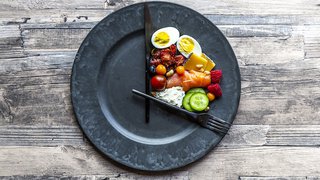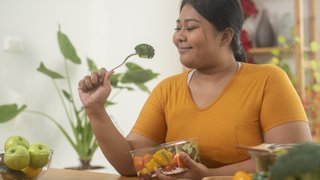6 health benefits of pumpkin and its spices – beyond the latte
October 23, 2023

Very few things scream autumn like pumpkin. From sipping spice-flavored lattes to decorating our doorsteps for Halloween and capping off Thanksgiving with a silky slice of pie, the festive gourds are a fall mainstay. (Some people might even say we’ve gone overboard for the gourd – pumpkin is in everything from puppy treats to protein bars!)
But along with being delicious and ubiquitous, pumpkin is also a nutritional powerhouse.
Rich in fiber, vitamins, and minerals, pumpkins help strengthen our immune systems and support healthy vision. A versatile food, pumpkin can be prepared in many ways: roasted, grilled, steamed, baked, boiled, blended, and even zapped in the microwave. Plus it’s available year-round, with less added salt and sugar than some other canned produce.
It’s tempting to add a lot of sugar and spice to accentuate the sweet and savory flavors of pumpkin (did someone mention PSLs?). But with a few simple swaps, you can retain the taste in a lighter, healthier treat.
Let’s talk about the many health benefits of eating pumpkin – including pumpkin spice! – and we’ll share a few easy, healthy recipes that highlight the taste of fall.
Why is eating pumpkin healthy?
Pumpkins, which are native to the Americas, are a type of winter squash. While scientifically pumpkin is a fruit because it contains seeds, nutritionally it is more like a vegetable and provides these six health benefits:
- Sharpens sight: One cup of pumpkin provides 200% of your daily recommended intake of vitamin A, which supports vision by protecting the cornea (your eye’s outer surface) and improves night vision – just in time to trick-or-treat! It also contains lutein and zeaxanthin, which can protect your eyes from macular degeneration and cataracts.
- Boosts immune system: Beta carotene, vitamin C, iron, and folate strengthen your immune system, and all are found in pumpkins.
- Lowers blood pressure: A pumpkin’s orange color is a sign that it’s packed with potassium, which helps lower blood pressure, strengthen the bones, and reduce your risk of stroke and kidney stones.
- Makes your skin look great: Pumpkins are loaded with antioxidants that are great for your skin and help combat the effects of aging. It also contains the provitamin beta carotene, which your body uses to produce vitamin A and vitamin C.
- Improves digestive health: Pumpkins are high in fiber, which keeps your bowel movements regular, promotes healthy weight management, and can help lower your cholesterol.
- Reduces cancer risk: Cancer cells produce free radicals to help them multiply quickly. Pumpkins are high in carotenoids, which combat the effects of free radicals in the body and may help protect against certain types of cancer.
Recipes: Healthy pumpkin spice latte | One-pot pumpkin curry | Easy roasted pumpkin seeds | Overnight pumpkin oats
Pumpkin spice can be good for you, too!
Pumpkin spice seems to be in everything these days: coffee, candy, desserts, cereal, cream cheese, power bars, the list goes on. Fortunately, the ingredients in pumpkin spice also can be good for your health:

- Cinnamon can help lower blood pressure and blood sugar.
- Allspice can support digestive health, help reduce inflammation, and keep your immune system functioning well.
- Cloves contain natural antimicrobial properties and manganese, which is important for bone health.
- Ginger helps promote digestion.
- Nutmeg is a rich source of antioxidants that can help protect against the signs of aging as well as serious illness such as cancer and heart disease.
While the ingredients of pumpkin spice can be good for you, the foods they are most popular in can contain a lot of added sugar. A 16-ounce pumpkin spice latte, for example, can have a whopping 50 grams of sugar. The American Heart Association recommends that men consume no more than 36 grams of added sugar each day and women no more than 25 grams. So, if you want to indulge in pumpkin treats and reap the health benefits, just remember to check the added sugar, which is present in a lot of processed foods.
Related reading: Added sugars: Sour news for our kids’ hearts
Tips for cooking with pumpkin
Pumpkins have a thick rind and messy seeds that can be intimidating if you’re not used to cooking with them. But it’s easier than you might think. Here are a few tips to get started:

- Choose “pie” pumpkins: Also called sugar or baking pumpkins, these are generally smaller than the decorative gourds you’ll find at the pumpkin patch. Pie pumpkins are sweet and flavorful with a smooth flesh that is easier to cut. They come in several varieties and can be round, oblong, orange, beige, and even white.
- Wash up: Before you start cooking, wash your hands. Then wash and dry the outside of the pumpkin.
- Use a sharp, serrated knife: Work slowly and be careful when cutting through the rind.
If you can’t find a baking pumpkin, don’t worry. Canned pumpkin often doesn’t have a lot of added salt or sugar. Look at the nutrition label closely – pumpkin pie filling is sweetened but canned pumpkin is not.
Try these healthy pumpkin recipes

Healthy pumpkin spice latte
(Source: The Clean Eating Couple)
Love a PSL but not the extra calories, sugar, and fat? Here’s a lighter version to enjoy.
Ingredients
1 cup almond milk
2 Tbsp pumpkin puree
1/4 Tbsp pumpkin pie spice
1 Tbsp maple syrup
1/4 cup espresso (1 large shot)
Directions
- Warm almond milk in a small saucepan. Whisk in pumpkin puree, spice, and maple syrup until combined. Don’t bring to a boil unless you like your drinks piping hot!
- While milk mixture is heating, make espresso.
- If you’d like, froth using a small electric or cup frother, or whisk the milk mixture vigorously in the pan. Pour milk mixture into a large mug and top with espresso. Stir gently and enjoy!
Nutritional Facts
Calories: 66; Protein: 2 g; Carbohydrate: 9 g; Dietary Fiber: 2 g; Total Sugars: 5 g; Total Fat: 3 g; Saturated Fat: 1 g
One-pot pumpkin yellow curry
(Source: Minimalist Baker)
This hearty, comforting curry recipe makes for a satisfying plant-based, gluten-free fall dinner.
Prep time: 15 minutes
Cooking time: 30 minutes
Servings: 4
Ingredients
1½ Tbsp coconut oil (or avocado or grape seed oil)
1 medium shallot (minced)
2 Tbsp minced fresh ginger
2 Tbsp minced garlic
1 small red chili or serrano pepper (stem and seeds removed, thinly sliced)
1 large red bell pepper (thinly sliced lengthwise)
3 Tbsp yellow (or red) Thai curry paste
3½ cups peeled and cubed pumpkin (or butternut squash)
2 (14-ounce) cans light coconut milk (sub full-fat for extra creamy texture or ½ of the coconut milk for vegetable broth for thinner curry)
2 Tbsp maple syrup or coconut sugar (plus more to taste or sub stevia to taste)
1 tsp ground turmeric
1 healthy pinch sea salt (about ¼ tsp)
1 Tbsp coconut aminos (or sub tamari or soy sauce if not gluten-free)
1 cup chopped broccoli
2 Tbsp lemon juice
2/3 cup roasted cashews (lightly salted or unsalted are best)
Directions
- Heat a large pot over medium heat. Once hot, add coconut oil, shallot, ginger, garlic, and pepper. Sauté for 2-3 minutes, stirring frequently.
- Add bell pepper and curry paste and stir. Cook for 2 minutes more. Then add pumpkin and stir. Cook for 2 minutes more.
- Add coconut milk, maple syrup or coconut sugar, turmeric, sea salt, and coconut aminos and stir. Bring to a simmer over medium heat.
- Once simmering, slightly reduce heat to low and cover. You want a simmer, not a boil, which should be around low to medium-low heat.
- Cook for 10-15 minutes, stirring occasionally, to soften the pumpkin and infuse it with curry flavor.
- At this time, also taste and adjust the flavor of the sauce/broth as needed. I added more maple syrup for sweetness, sea salt for saltiness, and a bit more curry paste for a more intense curry flavor. Don’t be shy with seasonings – this curry should be very flavorful.
- Once the broth is well seasoned and the pumpkin is tender, add broccoli, lemon juice, and cashews and cover. Simmer for 3-4 minutes more over low to medium-low heat.
- Optional: Scoop out half of the broth/sauce and half of the pumpkin (try to exclude the broccoli) and blend until creamy and smooth in a blender for a thicker, creamier curry. Return to pot and warm for a few minutes before serving.
- Serve as is or over rice, quinoa, or cauliflower rice. This dish gets elevated with the addition of fresh lemon juice and Thai or regular basil or cilantro for serving.
- Best when fresh, though leftovers will keep in the refrigerator up to 3-4 days or in the freezer for 1 month. Reheat on the stovetop or in the microwave until hot.
Nutritional Facts (1 of 4 servings)
Calories: 423; Carbohydrates: 39.9 g; Protein: 9.1 g; Fat: 29.1 g; Saturated Fat: 13.5 g; Trans Fat: 0 g; Cholesterol: 0 mg; Sodium: 459 mg; Fiber: 7 g; Sugar: 13.7 g
Easy roasted pumpkin seeds
(Source: Inspired Taste)
Don’t throw away the seeds from all your pumpkin carving. They can easily be turned into a delicious snack.
Prep time: 10 minutes
Cooking time: 25 minutes
Ingredients
1½ cups pumpkin seeds
2 tsp fine sea salt, plus more for serving
2 tsp olive oil
2 tsp your favorite spice blend such as curry powder, harissa, and chili powder
Directions
- Heat the oven to 350 degrees F. Line a baking sheet with parchment paper.
- Fill a medium saucepan with about 2 cups of water and season with 2 teaspoons salt. Bring to a boil.
- Meanwhile, scoop the seeds from your pumpkin. Add the pumpkin seeds to a bowl filled with cold water and swish them around until the seeds float and are mostly clean.
- Add cleaned seeds to the boiling salted water. Simmer for 5 minutes. Drain and pull away any remaining pumpkin attached to the seeds.
- Scatter the seeds onto clean dishcloths and pat them very dry. Mound the dried seeds onto the prepared baking sheet. Add the oil and any spices on top then toss until well coated. Spread the seeds into one layer. Bake, stirring the seeds at least once, until fragrant and golden around the edges, 10 to 25 minutes, depending on size of the seeds.
Nutritional Facts (serving size 2 TBS)
Calories: 105; Protein: 5 g; Carbohydrate: 2 g; Dietary Fiber: 1 g; Total Sugars: 0 g; Total Fat: 9 g; Saturated Fat: 2 g; Cholesterol: 0 mg
Overnight pumpkin oats
(Source: adapted from Plant-Based on a Budget Quick & Easy by Toni Okamoto)
I make this recipe quite a bit this time of year. It’s the perfect fall flavor to start the day.
Serves one.
Ingredients
¾ cup old fashioned/rolled oats
¼ cup canned pumpkin puree
¼ tsp pumpkin pie spice
1-2 tsp chia seeds (optional for thicker texture)
1 cup milk of choice (I use soy)
1.5 tsp maple syrup
Directions
- Combine all ingredients in a bowl or jar.
- Mix with a spoon or shake if using a mason jar with lid.
- Cover and refrigerate for at least 4 hours or up to overnight.
- Enjoy cold the next morning or heat and eat.
- May top with 2 Tbsp of toasted pecans (roast in over or air fryer at 350 degrees for about 5 minutes, until darkened).
Nutritional Facts
Calories: 323; Protein: 14 g; Carbohydrate: 50 g; Dietary Fiber: 9 g; Total Sugars: 18 g; Total Fat: 8.7 g; Saturated Fat: 1.2 g (without pecans)











